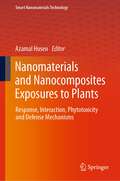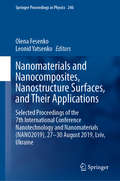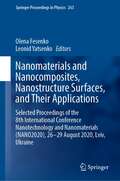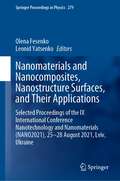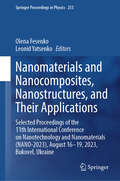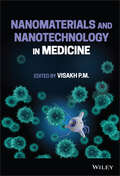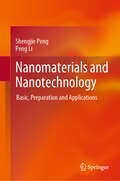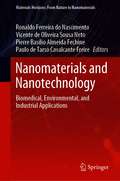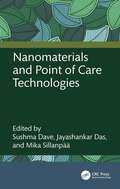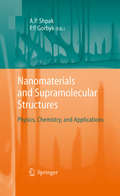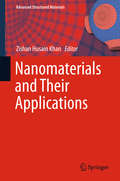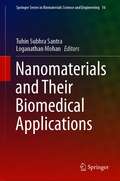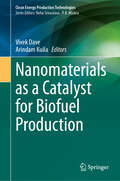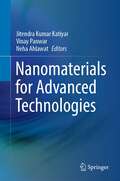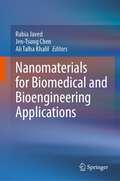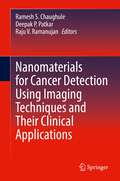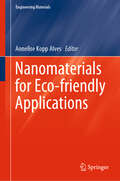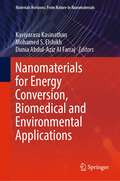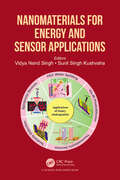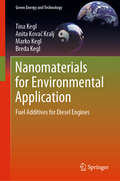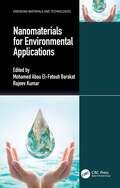- Table View
- List View
Nanomaterials and Nanocomposites Exposures to Plants: Response, Interaction, Phytotoxicity and Defense Mechanisms (Smart Nanomaterials Technology)
by Azamal HusenThis book looks at the interaction between plants and nanomaterials/nanocomposites, and their effects ecology, the food chain and human health. It focuses on nanomaterials/nanocomposites phytotoxicity, which is an important precondition to promote the application of nanotechnology and to avoid the potential ecological risks. It describes the influencing factors of nanotoxicity of nanomaterials and the mechanisms of these toxic effects and defense mechanisms in plants. The chapters in this book are written by internationally renowned researchers and professionals and provides exciting and remarkable information (on the above-mentioned topics) to the scientist, researcher and student working field of plant biology, agricultural science, nanobiotechnology, plant biochemistry, plant physiology, plant biotechnology and many other interdisciplinary subjects.
Nanomaterials and Nanocomposites for Environmental Remediation (Energy, Environment, and Sustainability)
by Avinash Kumar Agarwal Tarun Gupta Swatantra P. Singh Karthik RathinamThis monograph focuses on recent development of nanomaterials and nanocomposites for pollution measurement and their control in water, air, and soil. The contents incorporate carbon-based, metal-based, and metal-organic framework based nanomaterials and nanocomposites for emerging contaminants (pharmaceuticals and personal care products) degradation, disinfection, and other traditional pollutants degradation and removal. The book also offers updated literature for researchers and academicians working in the field of environmental remediation by nanomaterials. Readers will learn about different metal and non-metal based nanoparticles for environmental remediation. It will be a useful guide for professionals, and post-graduate students involved in material science & engineering, chemical engineering and environmental nanotechnology research.^
Nanomaterials and Nanocomposites, Nanostructure Surfaces, and Their Applications: Selected Proceedings of the 7th International Conference Nanotechnology and Nanomaterials (NANO2019), 27 – 30 August 2019, Lviv, Ukraine (Springer Proceedings in Physics #246)
by Leonid Yatsenko Olena FesenkoThis book highlights some of the latest advances in nanotechnology and nanomaterials from leading researchers in Ukraine, Europe and beyond. It features contributions presented at the 7th International Science and Practice Conference Nanotechnology and Nanomaterials (NANO2019), which was held on August 27–30, 2019 at Lviv Polytechnic National University, and was jointly organized by the Institute of Physics of the National Academy of Sciences of Ukraine, University of Tartu (Estonia), University of Turin (Italy), and Pierre and Marie Curie University (France). Internationally recognized experts from a wide range of universities and research institutions share their knowledge and key findings on material properties, behavior, and synthesis. This book’s companion volume also addresses topics such as nano-optics, energy storage, and biomedical applications.
Nanomaterials and Nanocomposites, Nanostructure Surfaces, and Their Applications: Selected Proceedings of the 8th International Conference Nanotechnology and Nanomaterials (NANO2020), 26–29 August 2020, Lviv, Ukraine (Springer Proceedings in Physics #263)
by Leonid Yatsenko Olena FesenkoThis book highlights some of the latest advances in nanotechnology and nanomaterials from leading researchers in Ukraine, Europe and beyond. It features contributions presented at the 8th International Science and Practice Conference Nanotechnology and Nanomaterials (NANO2020), which was held on August 26–29, 2020 at Lviv Polytechnic National University, and was jointly organized by the Institute of Physics of the National Academy of Sciences of Ukraine, University of Tartu (Estonia), University of Turin (Italy), and Pierre and Marie Curie University (France). Internationally recognized experts from a wide range of universities and research institutions share their knowledge and key findings on material properties, behavior, and synthesis. This book’s companion volume also addresses topics such as nano-optics, energy storage, and biomedical applications.
Nanomaterials and Nanocomposites, Nanostructure Surfaces, and Their Applications: Selected Proceedings of the IX International Conference Nanotechnology and Nanomaterials (NANO2021), 25–28 August 2021, Lviv, Ukraine (Springer Proceedings in Physics #279)
by Leonid Yatsenko Olena FesenkoThis book highlights some of the latest advances in nanotechnology and nanomaterials from leading researchers in Ukraine, Europe and beyond. It features contributions presented at the 8th International Science and Practice Conference Nanotechnology and Nanomaterials (NANO2020), which was held on August 25–28, 2021 at Lviv Polytechnic National University, and was jointly organized by the Institute of Physics, the National Academy of Sciences of Ukraine, Lviv Polytechnic National University, University of Tartu (Estonia), University of Turin (Italy), Pierre and Marie Curie University (France), European Profiles S.A. (Greece), Representation of the Polish Academy of Sciences in Kyiv, University of Angers (France), Ruprecht Karl University of Heidelberg (Germany). Internationally recognized experts from a wide range of universities and research institutions share their knowledge and key findings on material properties, behavior, and synthesis. This book’s companion volume also addresses topics such as nano-optics, energy storage, and biomedical applications.
Nanomaterials and Nanocomposites, Nanostructures, and Their Applications: Selected Proceedings of the 11th International Conference on Nanotechnology and Nanomaterials (NANO-2023), August 16-19, 2023, Bukovel, Ukraine (Springer Proceedings in Physics #253)
by Leonid Yatsenko Olena FesenkoThis book highlights some of the latest advances in nanotechnology and nanomaterials from leading researchers in Ukraine, Europe and beyond. It features contributions presented at the 11th International Conference on Nanotechnologies and Nanomaterials, and was jointly organized by the Institute of Physics of the National Academy of Sciences of Ukraine, University of Tartu (Estonia), University of Turin (Italy), and Pierre and Marie Curie University (France). Internationally recognized experts from a wide range of universities and research institutions share their knowledge and key findings on material properties, behavior, synthesis and their applications. The book will be interesting for leading scientists, advanced undergraduate and graduate students in material and nanoscience. This book’s companion volume also addresses topics such as nano-optics, nanoelectronics, energy storage and nanochemistry applications.
Nanomaterials and Nanotechnology in Medicine
by Dr P. M. VisakhNANOMATERIALS AND NANOTECHNOLOGY IN MEDICINE A comprehensive introduction to nanomaterials and their application in the field of medicine The use of nanotechnology and nanomaterials more generally is an emerging field that has generated a lot of interest in the last few years. To this point, there have been few books that deal with the recent advances in nanomaterials or nanocomposites in the medical discipline. Intended as a one-stop reference, Nanomaterials and Nanotechnology in Medicine provides the reader with the most-up-to-date and comprehensive exploration of the field of nanomedicine. The scope of the topic is huge, with nano applications in every medical specialization—from diagnostics to pharmaceuticals, from biological therapies to surgical devices, and from regenerative therapies to gene therapy. As such, this volume provides the most comprehensive coverage of this intriguing field of study. Nanomaterials and Nanotechnology in Medicine readers will also find: An application-oriented book dedicated towards helping researchers find solutions to both fundamental and applied problems Chapters written by leading researchers from industry, academy, government, and private research institutions across the globe Nanomaterials and Nanotechnology in Medicine is a useful reference for medical doctors, medical practitioners, post-doctoral research fellows, senior graduate students, and medical libraries.
Nanomaterials and Nanotechnology: Basic, Preparation and Applications
by Peng Li Shengjie PengThis book first systematically introduces the development history, research content, and development trend of nanomaterials and then describes the preparation methods, characterization methods, physical and chemical properties, and mechanical properties of nanomaterials, so that students can have an overall understanding and understanding of nanomaterials. On this basis, the application of nanomaterials and carbon nanomaterials which are widely studied at present is taught. Finally, the latest research progress of nanomaterials is introduced. The book lists some practical examples as far as possible to make students easy to understand and master.
Nanomaterials and Nanotechnology: Biomedical, Environmental, and Industrial Applications (Materials Horizons: From Nature to Nanomaterials)
by Ronaldo Ferreira do Nascimento Vicente de Oliveira Sousa Neto Pierre Basílio Almeida Fechine Paulo de Tarso Cavalcante FreireThis book provides a complete overview of a wide range of nanomaterials from their synthesis and characterization to current and potential applications with special focus on the use of such nano-based products as functional agents in biomedical, environmental and industrial applications. It addresses the intrinsic relationship between aspects involving the synthesis of nanocompounds, their bio-physico-chemical properties and their interactions occurring in biomedical, environmental and industrial matrix. This book is of interest to engineers, academics and research scholars working in these fields.
Nanomaterials and Photocatalysis in Chemistry: Mechanistic and Experimental Approaches (Materials Horizons: From Nature to Nanomaterials)
by Muhammad Bilal Tahir Khalid Nadeem RiazThis book demonstrates the basic and fundamental aspects of nanotechnology and potential application as a photocatalysis in multiple application especially in environment and energy harvesting. This book also contains methods of preparation and characterization of unique nanostructured photocatalysts, and details about their catalytic action. The book consists of seven chapters, including the principles and fundamentals of heterogeneous photocatalysis; the mechanisms and dynamics of surface photocatalysis; research on pure and composites based materials with unique nanostructures; the latest developments and advances in exploiting photocatalyst alternatives to WO3; and photocatalytic materials for applications other than the traditional degradation of pollutants, such as carbon dioxide reduction, water oxidation, a complete spectrum of selective organic transformations and water splitting by photocatalytic reduction. This book will appeal to a wide readership of the academic and industrial researchers and it can also be used in the classroom for undergraduate and graduate students focusing on heterogeneous photocatalysis, sustainable chemistry, energy conversion and storage, nanotechnology, chemical engineering, environmental protection, optoelectronics, sensors, and surface and interface science.
Nanomaterials and Point of Care Technologies
by Sushma Dave Jayashankar Das Sillanpää MikaPoint of care (POC) diagnostic devices are predominantly used for the diagnosis and monitoring of diseases. To make these technologies scalable for manufacturing, user-friendly, inexpensive, sensitive, and rapid, a combination of such devices with nanomaterials is required. This book deals with new emerging fields such as POC technologies and advanced nanotheranostics using nanomaterials and their technologies and applications in diagnosis. In this book, current advances for the application of nanomaterials such as carbon nanotubes, graphene, and magnetic nanoparticles in POC devices and future directions are reviewed.This book: Presents a comprehensive account of needs and challenges of POC diagnostics Describes the fundamentals of rationale of nanomaterials as remarkable building blocks for biosensing Discusses development of critical diagnosis in POC systems Deals with the advantages of nanomaterial-based sensing strategies Illustrates the challenges and breakthroughs of technologies for cost-efficient biosensing platform The book is aimed at researchers and professionals in nanotechnology and biomedical engineering.
Nanomaterials and Supramolecular Structures
by Petr Petrovych Gorbyk Anatoliy Petrovych ShpakThe text features experimental investigations which use a variety of modern methods and theoretical modeling of surface structures and physicochemical processes which occur at solid surfaces. Nanomaterials and Supramolecular Structures: Physics, Chemistry, and Applications is intended for specialists experienced in the fields of Nanochemistry, Nanophysics, Surface Chemistry (and Physics), synthesis of new nanostructural functional materials and their practical applications. It will also prove useful to students, post-graduates, researchers, and lecturers.
Nanomaterials and Their Applications (Advanced Structured Materials #84)
by Zishan Husain KhanThis book focuses on the latest advances in the field of nanomaterials and their applications, and provides a comprehensive overview of the state-of-the-art of research in this rapidly developing field. The book comprises chapters exploring various aspects of nanomaterials. Given the depth and breadth of coverage, the book offers a valuable guide for researchers and students working in the area of nanomaterials.
Nanomaterials and Their Biomedical Applications (Springer Series in Biomaterials Science and Engineering #16)
by Tuhin Subhra Santra Loganathan MohanThis book highlights the evolution of, and novel challenges currently facing, nanomaterials science, nanoengineering, and nanotechnology, and their applications and development in the biological and biomedical fields. It details different nanoscale and nanostructured materials syntheses, processing, characterization, and applications, and considers improvements that can be made in nanostructured materials with their different biomedical applications. The book also briefly covers the state of the art of different nanomaterials design, synthesis, fabrication and their potential biomedical applications. It will be particularly useful for reading and research purposes, especially for science and engineering students, academics, and industrial researchers.
Nanomaterials as a Catalyst for Biofuel Production (Clean Energy Production Technologies)
by Arindam Kuila Vivek DaveThis contributed volume addresses several environmental problems using nanoparticles/nanomaterials for renewable energy and biofuel production. It presents nanomaterials as catalysts that can enable better selectivity, yield, and quality in renewable energy and biofuel production. The rapid expansion of industries and human population has resulted in a significant increase in the generation of waste and environmental pollution, posing a significant threat to the environment and human health. People are looking for safer and more eco-friendly fuels to meet energy demand and preserve the world for future generations. Renewable energy and biofuels are alternative techniques that reduce fossil fuel consumption. The advancement in the field of nanotechnology has led to the development of nanocomposites/nanomaterials, which are composed of nanoscale particles and polymers. Their application in the environment has shown great potential in addressing environmental issues such as pollution control and waste management. Nanocomposites are advanced materials with unique properties, such as improved mechanical strength, thermal stability, and flame resistance, making them attractive for a wide range of applications, including environmental applications. Nanomaterials show great potential for sustainable biofuel production with commercial feasibility. Nanotechnology-based various conversion routes effectively convert waste biomass into value-added biofuels, such as syngas, biodiesel, and HVO. This book discusses the green synthesis of nanocomposites/nanomaterials for biofuel production and renewable energy. Additionally, it covers techno-economic analysis of bioremediation using green-synthesized nanoparticles/nanomaterials. This book will be helpful for researchers, engineers, and scientists working in the areas of environmental biotechnology, materials science, nanotechnology, environmental science, and engineering.
Nanomaterials for Advanced Technologies
by Jitendra Kumar Katiyar Vinay Panwar Neha AhlawatThis book presents experimental as well as simulation methodologies for analysis and development of nanostructures for introducing the desirable effects through modifications in the basic structure of select nanomaterials. The initial chapters in this book focus on exploring the basic aspects of nanomaterials, e.g., distinguishing features, synthesis, processing, characterization, simulation and application dimensions, or nanostructures that enable novel/enhanced properties or functions. The chapters also cover the size-dependent electronic, optical, and magnetic properties of nanomaterials in exposing the specific properties essential for applications in nanophotonics, nanoplasmonics, nanosystems (e.g., biological, medical, chemical, catalytic, energy, and environmental applications), and nanodevices (e.g., electronic, photonic, magnetic, imaging, diagnostic, and sensor applications). This book is a useful resource for students, researchers, and technologists in gathering recent knowledge on novel nanostructures and their use in different application areas.
Nanomaterials for Biomedical and Bioengineering Applications
by Jen-Tsung Chen Rabia Javed Ali Talha KhalilThis book accumulates the most recent advancements in the field of bioengineering regarding hybrid science named nanobiotechnology and enriches the readers with vast and comprehensive knowledge about different biomedical applications of nanomaterials. It includes drug and gene delivery, tissue engineering, antimicrobial properties, hyperthermia, cancer therapy, bioimaging, biosensing, photoablation therapy, etc., utilizing the potential of different nanomaterials that are helpful for the well-being of diseased individuals. Furthermore, the concerns about multidrug-resistant microorganisms are increasing daily in the healthcare system. Since conventional therapies fail to combat various infectious diseases, novel nanotechnology techniques provide an alternative approach to developing innovative biomaterials. The novel features of nanomaterials need to be exploited for use in the biomedical engineering domain. They should be fabricated so that the novel multifunctional nanomaterials notonly improve drug efficacy but also reduce their side effects. Moreover, a detailed understanding of the nanotoxicological effects of promising biomedical nanomaterials should necessarily be explored using the cell culture approach. Corona of nanomaterials should be investigated in detail to determine its fate in the biological system regarding safety concerns. This is the most important feature that is novel and explored in this book and would be very helpful for customers like clinicians, scientists, engineers, and technicians who will gain extensive knowledge from this book and work together to get the desired results in the healthcare sector.
Nanomaterials for Cancer Detection Using Imaging Techniques and Their Clinical Applications
by Ramesh S. Chaughule Deepak P. Patkar Raju V. RamanujanThis book presents nanomaterials for cancer detection using a variety of state-of-the-art imaging techniques. Clinical applications are also highlighted. The unique size-dependent properties and convenient surfaces for molecular assembly make these nanomaterials essential for a variety of innovative imaging techniques. This book covers important imaging modalities, synthesis of nanoparticles with specific functional properties, and clinical applications including the development of anticancer drugs. The information presented here involves contributions from chemistry, materials science, materials characterization, cell engineering, and clinical testing.The book will be essential reading to experienced clinicians as well as a wide range of scholars and researchers interested in nanotechnology and imaging techniques for cancer detection.
Nanomaterials for Eco-friendly Applications (Engineering Materials)
by Annelise Kopp AlvesThis book presents a wide range of synthesis and characterization techniques to produce ceramic nanomaterials specially developed to be used in environmental applications. The book cover synthesis using hydrothermal, chemical vapor deposition, sol-gel, emulsification, magneto-sputtering, among other process and modern characterization techniques with detail. The use of the synthesized materials in eco-friendly approaches such as photocatalysis, solar energy efficiency improvement, absorbents, sensors, solar cells, biofuels and waste reuse are reported in detail.
Nanomaterials for Electrochemical Energy Storage Devices
by Suneel Kumar Srivastava Poulomi RoyEnergy storage devices are considered to be an important field of interest for researchers worldwide. Batteries and supercapacitors are therefore extensively studied and progressively evolving. The book not only emphasizes the fundamental theories, electrochemical mechanism and its computational view point, but also discusses recent developments in electrode designing based on nanomaterials, separators, fabrication of advanced devices and their performances.
Nanomaterials for Energy Applications (Emerging Materials and Technologies)
by Shaik Feroz L. Syam Sundar Faramarz DjavanroodiNanomaterials for Energy Applications provides readers with an in-depth understanding of advanced nanomaterials and their applications in energy generation and utilization concepts. It focuses on emerging nanomaterials and applications in various energy-related fields. Describes nanomaterials for use in photovoltaic cells, solid state lighting, fuel cells, electrochemical batteries, electrochemical capacitors, superconductors, hydrogen storage, and photocatalysts. Focuses on commercial and economic aspects. Includes case studies drawn from practical research. This book is aimed at researchers, advanced students, and practicing engineers in the disciplines of materials, mechanical, electrical, and related fields of engineering.
Nanomaterials for Energy Conversion, Biomedical and Environmental Applications (Materials Horizons: From Nature to Nanomaterials)
by Kaviyarasu Kasinathan Mohamed S. Elshikh Dunia Abdul-Aziz Al FarrajThis book highlights a multidisciplinary system for the future while protecting our environment. Certainly, the main objective of the proposed book has addressed several issues and bringing a good platform to understanding for future developments in metal oxide nanostructures for energy conversion, biomedical, and environmental management, however, which is support/carrier for antibacterial behaviors, pathogen infections, and bioinspired materials for energy savings and environmental impacts. Appropriately, I recommend the book to undergraduates, postgraduates, and doctoral students those who are working in materials science and researchers across the world working in interdisciplinary research.
Nanomaterials for Energy and Sensor Applications
by Vidya Nand Singh Sunil Singh KushvahaNowadays, most of the research focuses on nanomaterials in which one of the dimensions falls in the 1-100 nm range. These nanomaterials can be thin films, quantum dots, nanowires, nanopyramids, and nanoclusters. Thus, nanomaterials are impacting almost all aspects of materials for various applications in emerging energy and sensor devices. The book comprises ten chapters and discusses nanomaterial applications in energy, solar cells, water splitting, sensors, etc. The book caters to budding researchers’ needs in synthesizing nanomaterials and post-graduate students.
Nanomaterials for Environmental Application: Fuel Additives for Diesel Engines (Green Energy and Technology)
by Breda Kegl Marko Kegl Tina Kegl Anita Kovač KraljThis book explores the use of nanomaterials as diesel fuel additives. It extensively reviews the diesel engine characteristics and the most frequently used nanomaterials and nanofuels and discusses the practical issues regarding the viability of nanomaterials as fuel additives from technical, environmental, and human health viewpoints. Special attention is focused on questions related to the short-term use of nanomaterials in diesel engines, such as: · What are the most important nanomaterial activities in diesel engines? · What happens to nanomaterials at various stages, from the fuel tank to exhaust? · What are the effects of nanofuel usage on diesel engine characteristics? and · What are the effects of nanomaterials on diesel engine parts and systems? Given its scope, this book is a valuable resource for researchers and engineers in environmental science, mechanical engineering, and chemical engineering fields, as well as for advanced undergraduate and postgraduate students.
Nanomaterials for Environmental Applications (Emerging Materials and Technologies)
by Mohamed Abou El-Fetouh BarakatNanomaterials for Environmental Applications offers a comprehensive review of the latest advances in nanomaterials-based technologies for the treatment of emerging contaminants in wastewater. It describes the latest developments in the synthesis protocols, including the synthesis of different kinds of nanostructure materials using various physical and chemical methods. Features Discusses the synthesis and characterization of important nanomaterials such as carbon nanostructures, metal and metal oxide nanostructures, polymer nanostructures, and smart 1D-–3D nanomaterials Presents the latest techniques used in the characterization of nanomaterials Covers environmental applications including the remediation of pollutants in wastewater and water purification and disinfection Examines the sources, fate, transport, and ecotoxicology of nanomaterials in the environment. Aimed at researchers and industry professionals, this work will be of interest to chemical, environmental, and materials engineers concerned with the application of advanced materials for environmental and water remediation. Mohamed Abou El-Fetouh Barakat is a Professor of Environmental Sciences at both King Abdulaziz University (KAU)- Saudi Arabia, and Central Metallurgical R&D Institute (CMRDI)- Egypt. He is highly qualified in the fields of industrial waste management and pollution control as well as catalysis and nanotechnology. His experience includes academic research works in Japan, Germany, the United States and Saudi Arabia, as well as initiating and leading industrial research projects in Egypt jointly with the United States. Rajeev Kumar is an Associate Professor in the Environmental Science Department, King Abdulaziz University, Jeddah, Saudi Arabia. His research activities are in the areas of wastewater treatment and materials science. He studies the adsorption and photocatalytic properties of nanomaterials for the removal of contaminants from wastewater.
